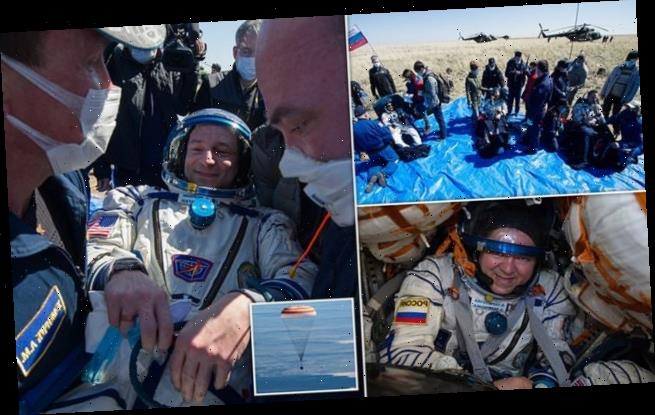Welcome to the pandemic! Mask-wearing medics greet the International Space Station crew as they return to Earth after 200 days orbiting the planet
- The international crew touched down in Kazahkstan after returning from the ISS
- Their Soyuz capsule landed at 06:15 BST and they were met by masked doctors
- Doctors meeting them have all been regularly tested for the deadly COVID-19
- Learn more about how to help people impacted by COVID
Astronauts who have spent the past 200 days on the International Space Station have returned to Earth in the middle of the coronavirus pandemic.
The international crew of NASA and Roscosmos astronauts were met by face mask wearing doctors after landing safely in Kazakhstan at 06:15 BST on Friday.
NASA astronauts Andrew Morgan and Jessica Meir were joined in the Soyuz capsule by Russian space agency Roscosmos cosmonaut Oleg Skripochka.
Russian officials said they took stringent measures to protect the crew amid the pandemic including ensuring the recovery team had been tested for the virus.
NASA astronaut Jessica Meir (pictured) was among the crew of three returning to Earth from the International Space Station amid the COVID-19 pandemic
Russian cosmonaut Oleg Skripochka of Roscosmos (pictured) and US astronauts Jessica Meir and Andrew Morgan of NASA made a parachute-assisted landing in Kazakhstan
The Russian-made capsule landed under a striped orange-and-white parachute about 93 miles south-east of Dzhezkazgan in central Kazakhstan.
The recovery team and medical personnel assigned to help the crew out of the capsule and for post-flight checks had been under close medical observation for nearly a month, according to Roscosmos officials.
The space crew smiled as they talked to medical experts wearing masks.
Following a quick check-up, the crew will be flown by helicopters to Baikonur, from where Skripochka will be taken to Moscow, said Vyacheslav Rogozhnikov, a Russian medical official who oversaw the crew’s return.
Morgan and Meir will have to be driven from Baikonur to Kyzyl-Orda, 190 miles away, to board a flight to the US.
This is a strenuous and unusual journey for a crew used to zero-gravity but was made necessary by Kazakhstan’s quarantine measures.
The crew returned to Earth exactly 50 years after the Apollo 13 astronauts splashed down in the Pacific after an oxygen tank explosion aborted the moon-landing mission – as shown in the Tom Hanks film of the same name.
Morgan wrapped up a 272-day mission on his first flight into space which saw him make seven space walks, four of which were to improve and extend the life of the station’s Alpha Magnetic Spectrometer.
The spectrometer is used to look for evidence of dark matter in the universe.
Meir and Skripochka spent 205 days in space, with Meir carrying out the first three all-women spacewalks with her crewmate Christina Koch, who returned from space in February.
Speaking from the orbiting outpost before the return to Earth, the crew said that coming back to the world drastically changed by the pandemic will be challenging.
US astronaut Andrew Morgan of NASA is assisted by support personnel after landing aboard the Soyuz MS-15 capsule with two other ISS Expedition 62 crew members in Kazakhstan
ISS Expedition 62 crew members are assisted by support personnel after landing aboard the Soyuz MS-15 capsule in Kazakhstan
Russian cosmonaut Oleg Skripochka of Roscosmos and US astronauts Jessica Meir and Andrew Morgan of NASA made a parachute-assisted landing after departing the International Space Station
Morgan said the crew has tried to keep atop the coronavirus news, but added that it was hard to comprehend what was really going on.
‘It is quite surreal for us to see this whole situation unfolding on the planet below,’ said Meir.
‘We can tell you that the Earth still looks just as stunning as always from up here, so it’s difficult to believe all the changes that have taken place since both of us have been up here.’
A new crew comprising NASAs Chris Cassidy and Roscosmos’ Anatoly Ivanishin and Ivan Vagner arrived at the station on April 9.
They said before blast-off that they had been under a very strict quarantine for a month before the flight and were feeling good.
On Thursday, the Russian government coronavirus headquarters reported the first contagion at the Star City, which serves as the main hub for pre-flight training of US, Russian and other international crew members of the International Space Station.
The Star City also has residential quarters for cosmonauts and support staff.
Roscosmos director Dmitry Rogozin said on Wednesday that the Russian space corporation had 30 coronavirus cases.
WHAT IS THE INTERNATIONAL SPACE STATION?
The International Space Station (ISS) is a $100 billion (£80 billion) science and engineering laboratory that orbits 250 miles (400 km) above Earth.
It has been permanently staffed by rotating crews of astronauts and cosmonauts since November 2000.
Research conducted aboard the ISS often requires one or more of the unusual conditions present in low Earth orbit, such as low-gravity or oxygen.
ISS studies have investigated human research, space medicine, life sciences, physical sciences, astronomy and meteorology.
The US space agency, Nasa, spends about $3 billion (£2.4 billion) a year on the space station program, a level of funding that is endorsed by the Trump administration and Congress.
A U.S. House of Representatives committee that oversees Nasa has begun looking at whether to extend the program beyond 2024.
Alternatively the money could be used to speed up planned human space initiatives to the moon and Mars.
Source: Read Full Article





